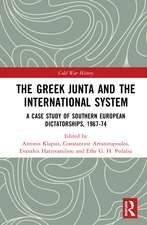The Institutional Transition of China's Township and Village Enterprises: Market Liberalization, Contractual Form Innovation and Privatization: The Chinese Trade and Industry Series
Autor Hongyi Chenen Limba Engleză Paperback – 11 noi 2019
| Toate formatele și edițiile | Preț | Express |
|---|---|---|
| Paperback (1) | 150.13 lei 6-8 săpt. | |
| Taylor & Francis – 11 noi 2019 | 150.13 lei 6-8 săpt. | |
| Hardback (1) | 461.22 lei 6-8 săpt. | |
| Taylor & Francis – 2 noi 2017 | 461.22 lei 6-8 săpt. |
Preț: 150.13 lei
Preț vechi: 178.97 lei
-16% Nou
Puncte Express: 225
Preț estimativ în valută:
28.73€ • 30.07$ • 23.77£
28.73€ • 30.07$ • 23.77£
Carte tipărită la comandă
Livrare economică 05-19 aprilie
Preluare comenzi: 021 569.72.76
Specificații
ISBN-13: 9780415791809
ISBN-10: 0415791804
Pagini: 294
Dimensiuni: 152 x 232 mm
Greutate: 0.54 kg
Ediția:1
Editura: Taylor & Francis
Colecția Routledge
Seria The Chinese Trade and Industry Series
Locul publicării:Oxford, United Kingdom
ISBN-10: 0415791804
Pagini: 294
Dimensiuni: 152 x 232 mm
Greutate: 0.54 kg
Ediția:1
Editura: Taylor & Francis
Colecția Routledge
Seria The Chinese Trade and Industry Series
Locul publicării:Oxford, United Kingdom
Cuprins
Contents: Introduction; Local government leaders, firm managers, and the two-tier property rights structure of collective TVEs; The contractual structure of collective TVEs; Modeling the contractual structure of collective TVEs; Explaining the contractual form innovation in collective TVEs; Endogenous reform and induced privatization: Concluding remarks; Bibliography; Index.
Recenzii
’This study is a useful addition to the rich literature on the evolution of China’s TVEs...it gives a clear picture of some major causes for the shift to profit sharing, leasing and sales.’ China Information
Descriere
This title was first published in 2000. This text examines China’s township and village enterprises from a new angle. An empirically rich study, it provides new insight into China’s institutional transition towards a market system. It explains how a bottom-up endogenous, instead of top-down exogenous, property rights reform can be realized in transitional economies.































